The Barnevelder breed profile

The Double Laced Barnevelder is a large, soft feathered, docile and very good natured chicken. They are very tame and do not fly well. They are a very pretty bird with interesting markings and a beautiful iridescent beetle sheen on the feathers. Barnevelder chickens are a rare dual purpose breed producing about 180/200 large brown speckled eggs per year.
The Barnevelder in brief:
Breed Size: Large Fowl, heavy.
Feather Type: Soft feathered.
Breed Purpose: Dual Purpose, kept for eggs and meat.
Comb: Single and straight.
Broodiness: Average .
Climatic Tolerance: All Climates, especially cold.
Productivity: 180/200 eggs / year. Meat - Slow growing, table ready from 6 months.
Egg Size: Medium to large depending on how your country classifies eggs. Dependable egg layers
Egg colour: Should be brown to speckled golden brown but most are cream to light brown.
Temperament: Friendly,Calm,Bears confinement well. Easy to tame and good with kids. Roosters calm.
Breed Colours/Varieties: Many, see exhaustive list below. some countries allow more types than others
Weight: A Barnevelder hen averages between 6.5 and 8.5 lb and the cockerels about 10/14 lb although the breed standards are quite strict on the size and weight of show birds.
Below: This is my flock lazing around in the sunshine:
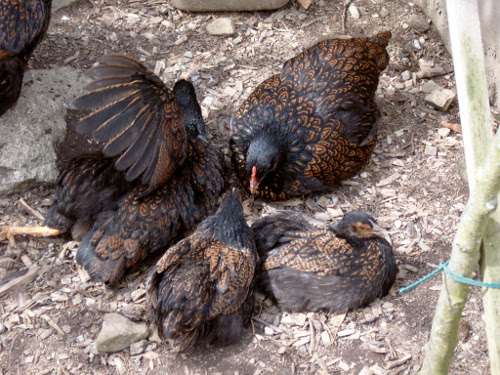
Barnevelders are good with children and make excellent backyard chickens. If handled when young they can be very tame. They adapt well to both free range and urban environments. Barnevelders are excellent foragers and feed themselves well if allowed to roam.
The Double Laced Barnevelder is a wonderful bird that has a good reputation as a winter layer. To my knowledge this breed produces the most consistent supply of eggs year round without any artificial light. I chose them specifically because they are hardy birds with small combs that tolerate the cold.
What does the Barnevelder look like?
The Barnevelder is a large fowl, soft feathered chicken with clean yellow legs and skin and four toes to each foot. They have a single comb, red bay coloured eyes and a horn coloured beak.
Comb, wattles and earlobes are all red with no white in the earlobes. There are various feather patterns and colours. The feathers of all breeds and types have a green beetle sheen.
Barnevelders are a well mannered, happy go lucky docile breed.
Barnevelder breed images:
A selection of photographs of my Barnevelders of varying types.
Below: Day old Silver Laced Barnevelder chicks.
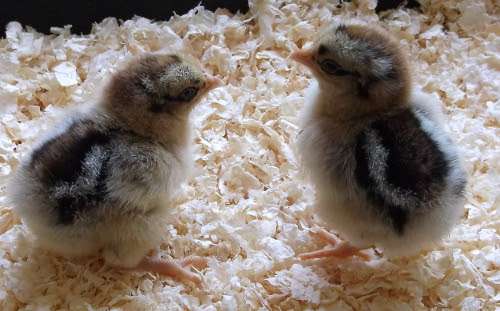
Below: A Blue Laced Barnevelder hen.
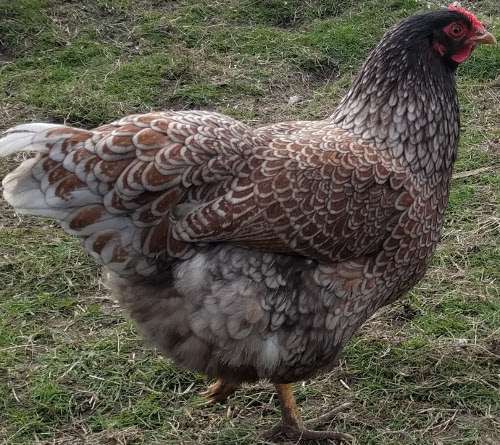
Below: A Gold laced or Chesnut cockerel.
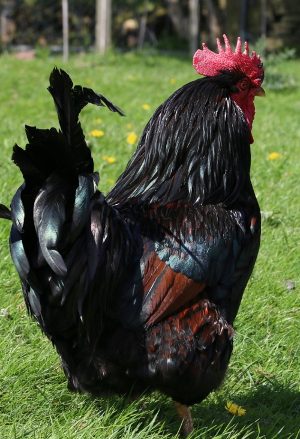
See more Barnevelder images in the gallery.
Barnevelder breed video:
Below: Here is a video of some of my Silver Laced Barnevelder bantams eating some sprouted seed.
Are Barnevelders good layers?
Yes, the Barnevelder is an excellent layer for a rare breed chicken. It is common for them to produce 200 eggs in their first year and maintain good productivity for 5 years. They are also excellent winter layers, mine produce around 30 eggs each over the 3 months of winter.
I have had some that still lay some eggs into their seventh year.
Sir Edward Brown wrote of the breed "The benefits of of this breed aren't confined to the large golden eggs, because the birds themselves are extremely attractive with beautiful glossy double laced feathering"
What colour egg does the barnevelder lay?
The Barnevelder lays a large golden brown, sometimes speckled egg that is a rich warm colour.
Below: Barnevelder eggs.
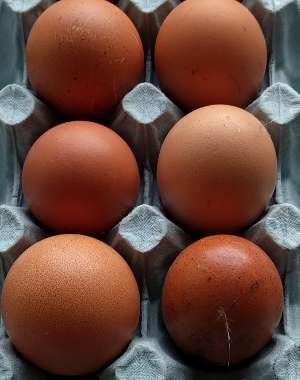
The barnevelder lays a fantastic brown egg of high quality. It has never been really dark like that of the welsummer or some strains of Marans I have seen recently.
Hans Schippers, an authority on the breed, noted that "Barnevelders don't always show their brown eggs. When they start to lay the colour is good to reasonable but often, with time, it starts to lighten. Highly productive birds will always lay a lighter egg."
He continues "The important point is the size and form of the egg, which should be large and thick. Eggs of these proportions generally show a better colour."
These eggs are from my double laced blues. A shade or two lighter than I would like but a work in progress.
Read more about the Barnevelder egg.
Do Barnevelders go broody?
Yes, I reckon around one third of my flock go broody at some stage in the year.
Below: One of my broody Barnevelder hens.
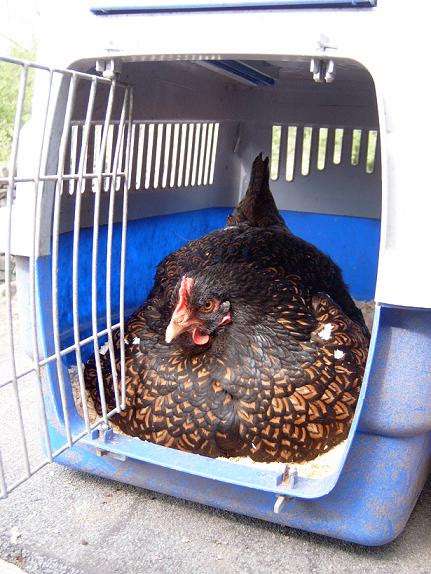
The are good sitters and careful attentive mothers with an excellent success rate.
How long do Barnevelders live?
The average is 5 to 7 years but I have 2 birds that are 11 this spring so they can be quite long lived.
The Origin and History of the Barnevelder:
Barnevelders had a rural birth in the town of Barneveld in the Netherlands, east of Utrecht. It was part of the poultry centre of the Dutch poultry industry and Barneveld has an agricultural college that specialised in poultry and the region is thought to have exported 40 million eggs a year during the 1930’s.
Whilst we know roughly what chickens were kept in the region at the time, the real origin of the Barnevelder can only really be guessed at.
From 1870 to 1900 a transformation was happening the egg markets of northern Europe and the first requirement for Dutch chicken breeders was to satisfy the desire for brown shelled eggs for the English market.
Egg producers need to make sure they had the hens to satisfy demand, once the breeds with winter laying ability had been produced to smooth out supply which was an absolute necessity in the northern latitudes.
The first step to standards was done by B.H. Bertels in 1898 when imported gold laced Wyandotte’s, from America, were added to the gene pool. The new breed was first exhibited in 1911 in The Hague but there was still considerable variability in the look of the birds.
in 1899 it was noted that the fowl on certain farms had a certain uniformity probably from the way they chose eggs for setting and always used dark cockerels for breeding.
From 1910 onward efforts were made to obtain more uniformity in colour and type. in 1921 the association of Barneveld breeders was established and they did much to further the breed. The colour of the feathers hows considerable similarity to that of the Indian gamecock although this breed was never used in the creation of the Barnevelder.
The First World War interrupted the development of the breeding, for showing, of all chickens not just Barnevelders.
The breed was introduced into England after the breed was seen at the World poultry congress in 1921 and shortly after a shipment of day old chicks was flown to the UK, spare birds were sold quickly and the Barnevelder club was formed the year after.
Below: Classic oil painting of the Barnevelder, notice the solid black breast.
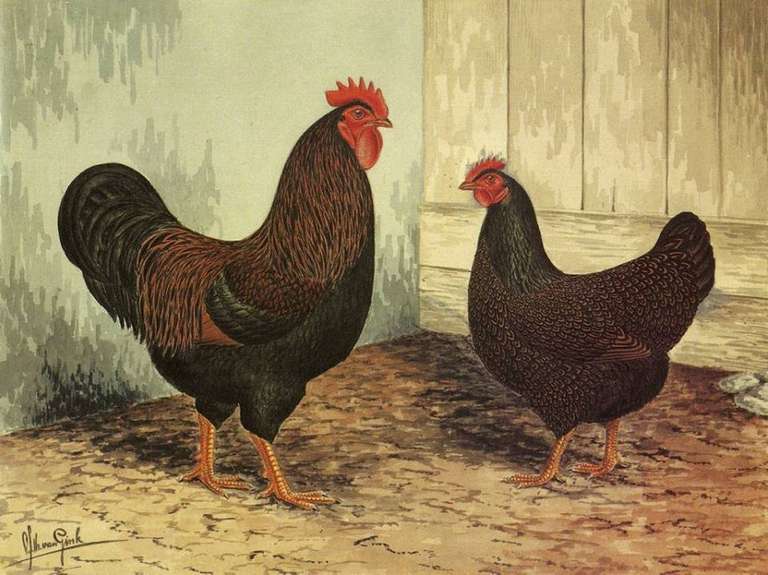
Original artist A.J. Simpson. Poster was a free gift in feathered World Magazine in October 1926
When the Barnevelder breed was first being standardised, it should be remembered that the plumage pattern were variable and a breed standard could not be published for the Barnevelder until the matter had been fully settled.
The British Barnevelder club couldn’t just translate and ratify the standard of the Netherlands as the plumage varied there as well.
Then in 1923 after feathers were sent to England from the Netherlands, the first Barnevelder breed standard was passed by the Poultry Club Great Britain in 1923 and the Barnevelder as we know it today became the standard, up until then the partridge was more common with the bird really only being selected for its brown egg and winter laying abilities.
The standard called for a Solid black breast on the males and allowed for either a partridge or double laced, which has gone on to be by far the most common type similar in markings to the familiar dark Indian game. All types required predominately black neck feathers.
The difference can still be seen today with the single laced breast of the English males and the deeper, more solid black of the European type. It should be noted that it is impossible to breed males with a double laced breast and there has been plenty of trying over the years.
Below: These are Silver Laced Barnevelder Bantam chicks:

The quest to produce the clean even lacing is what ultimately ruined the egg colour of the original Barnevelder, crossing with Indian game as the black breasted males struggled to produce good lacing in the hens. Brown egg birds have a tendency to be lighter in colour and have a paler undercolour.
The standards were revised 8 years later in 1931 and the newer type single laced breasted males with wing bars and the partridge keeping to the original standard.
In the Netherlands only the double laced is standardised but here in the UK the partridge is still allowed but is thought to be extinct.
The barnevelder breed standard is now over 90 years old and is experiencing a resurgence in popularity along side the increase in people keeping chickens at home.
The advantage of larger breeds like the barnevelder is they are less susceptible to attack from cats and tend to be more docile making better pets. The breed standard has been relatively well maintained as the Barnevelder was a popular bird for many years although the eggs are not as dark as they used to be.
The eggs have become lighter as the breed moved from being a utility bird to the show arena. The eggs used to be really dark similar to Welsummer eggs, except the Barnevelder eggs have always been speckled.
I gather that birds that lay lighter eggs are better layers as evidenced by the fact that birds like Rhode Island reds ( light brown ) and barred rocks ( white ) lay closer to 250/280 eggs per year.
Types of Barnevelder:
There are a great many types of Barnevelder , a lot of them are in the hands of dedicated breeders and not really readily obtainable . Often the rarer types are poor examples of the breed.
The breed was developed in the 1850's by crossing the local fowl with imported breeds from the east. The Barnevelder breed was standardised in 1921. The original and most widely available is the double laced variety. Several other varieties have been produced since by cross breeding, including a bantam double laced (1931).
Most of the dates may not be particularly accurate, unless official ratification dates by poultry standards. Also If you are looking at re-creating any of the breeds you will need to quite a lot of your own research as the birds used in the production of others are hearsay reporting or in some cases guesswork.
This is how we re-created the Silver Double Laced Large fowl Barnevelder
Double-laced (large fowl) - Bred in Barneveld, Netherlands in the late 19th / early 20th century. This is the most widely known type. Now called the Chestnut in the UK.
I have 22 hens in 4 breeding groups. I adore keeping these birds, they are so happy and docile wandering around my fields.They are not the most prolific layers, or have the biggest eggs, but the quality of the eggs is really high, mine lay an average of 183 in their first year.
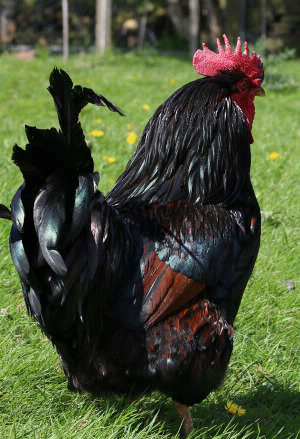
Barnevelders come in a considerable number of variations in both the bantam and large fowl. The standard gold double laced seems to be the most common kept here in the UK.
Barnevelder forage well and are very easy to tame and as such make excellent pets as well as eggs producers. Their wings are quite high on their body and they do not fly particularly well. They like there own company and rarely if ever squabble, mine even share nests and brooding without any fuss.
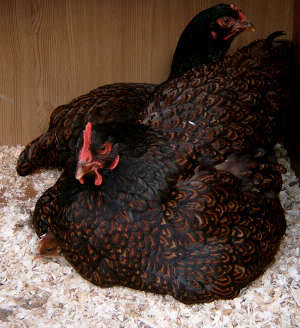
Above is two of my broody hens sharing the duty on a nest. They are looking after 27 chicks between them and make very good mothers.
The deep speckled chestnut brown eggs are a rarity these days. This picture below is a selection from my birds:
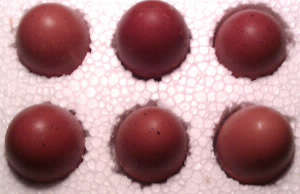
Barnevelder chicks - are incredibly cute and easy to look after.
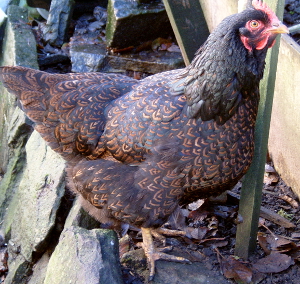
Double-laced (Bantam) - Recognised in 1931 in Germany. Bred from a 'petite' double-laced hen and a Bantam Rhode Island Red cock, followed by crossings with Bantam Golden-laced Wyandottes, Bantam German Langshan, and Bantam Indian Game (Cornish).
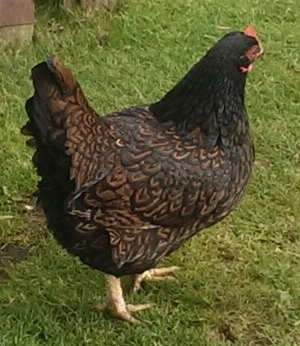
The first record of the bantam was from the Utrecht show in 1921 when Mr Van Dyk won the class. German strain appeared in 1922 by crossing undersized Barnevelders with other bantams and were exhibited from 1927 to the 1930’s.
It is unlikely that pre-war bantams either laid brown or survived the Second World War but when peace returned breeding continued with the production of black and white bantam Barnevelders between 1954 and 1960 by crossing with Wyandotte’s and then breeding to remove the rose comb.
Mrs Mainwaring is credited with the production of the English bantams during the 1920’s and won several prises with them at shows in the north of England in 1928. I have never seen a bantam Barnevelder that lays a dark egg, the best mine produce is a speckled cream tinted one.
Double-laced Blue (large fowl) - Blue laced – the blue double laced is very attractive and has blue lacing over a red brown colour and was developed by Dutch and German fanciers. There genetics of the blue is complicated and it is difficult to produce evenly colours birds.
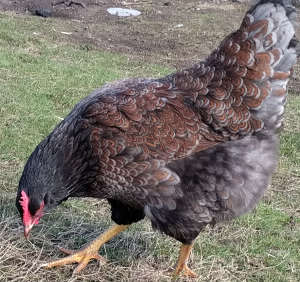
One of my favourites.
Double-laced Blue (Bantam) - Originally bred in the Netherlands. Bred again in Germany from a Bantam double-laced Barnevelder cock and a Bantam blue-laced Wyandotte hen; recognised in 1987.
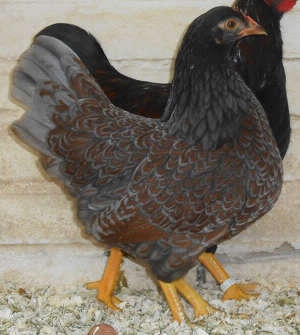
Blue (large fowl) - Recognised in Germany in 1997. Bred from Black Barnevelder and Blue Niederrheiner. Not recognised in the Netherlands.
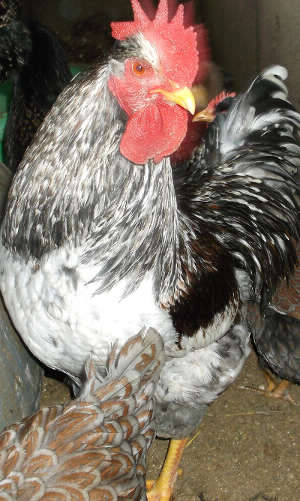
Also called splash.
Silver (large fowl) - Appears to be a recognised variety in the British & Australian Poultry Standards. Single-laced.

They do exist although I have never found them popular. I have kept a trio purely for nostalgic reasons and I have never seen any others.
Silver-black double-laced (Bantam) - Developed in the first years of the new millennium by Dutch breeder Bert Beugelsdijk from crosses of double-laced Barnevelder bantams and Silver-pencilled Wyandotte bantams. Recognised in 2009. With black pattern over a white ground colour was standardised in 1938 but good quality specimens are very rarely seen, there is a problem with red leakage in most hobby produced birds and errors in the markings stick out like a sore thumb.
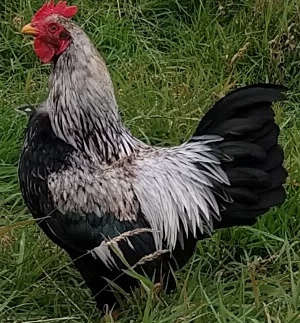
I am particularly proud of my bantam Barnevelders, I bred them myself from a standard double laced and bantam wyandotte.
Silver-black double-laced (large fowl) - Developed by the Dutch breeders Gerrit Simmelink and Cor Tensen from crosses of a large Silver-pencilled Wyandotte rooster and large double-laced Barnevelder hens. Recognised in 2013. Also recognised in New Zealand Poultry Standards 2013.
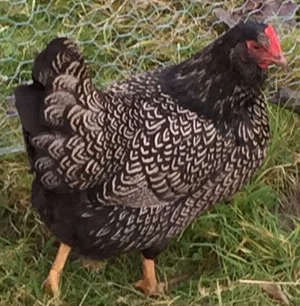
Good examples are very rare and stunning.
Silver Blue Barnevelder - Cross of the Silver and blue double laced.

One of my current projects.
Black (large fowl) - 1920s. Black came as a sport from the partridge. Black Plymouth Rock and Black Wyandottes were crossed in to achieve pure black. they have always had a tendency to be dark and a few people had the idea to select the darker birds and selectively breed a black variety, as they were too dark for show and normal breeding programmes.
A separate club for the blacks was founded in 1925 in the United Kingdom and the new type was accepted by the poultry club in 1928. There was always a little brown until they were crossed with pure black breeds lie the black Plymouth or Wyandotte.
Although when using the Wyandotte several years would be required to dispose of the rose comb. The ubiquitous problem in Barnevelders that have been crossed to produce types is they are unlikely to produce brown eggs, an ability, once lost are very difficult to restore.The clubs eventually merged into 1.
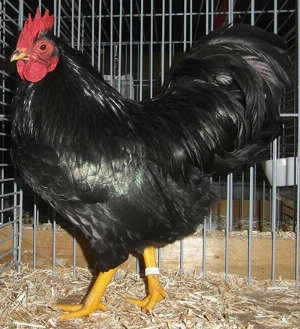
Black (Bantam) - Recognised in 1954 in Germany. Bred from Black Barnevelders and Bantam Black Wyandottes in Germany.
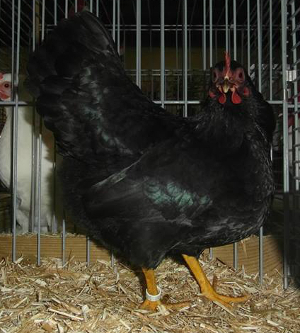
White (large fowl) - 1934. Occasionally occurring recessive white birds were crossed with white Plymouth Rocks and White Leghorn to produce White Barnevelders.
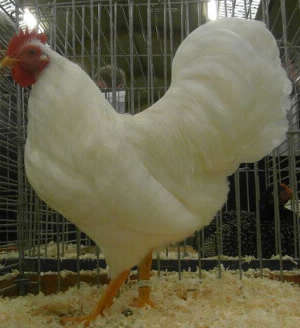
White (Bantam) - Recognised in 1960 in Germany. Bred from Black Barnevelders and Bantam White Wyandottes in Germany.
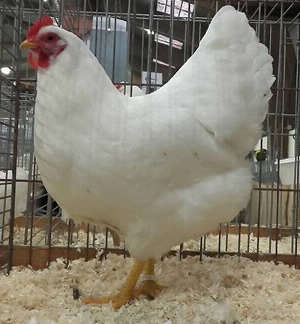
Auto-sexing barred (large fowl) - This is the only reference and image i can find of the auto sexing barred Barnevelder.
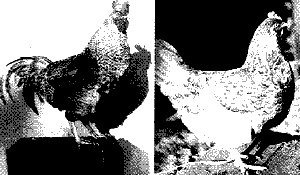
The auto-sexing Barnevelder was produced by adding the barring gene to a good strain by a repeated system of backcrossing. The males are homozygous for the gene and are hatched whitish and grow up light barred. The females being haplozygous are hatched brown striped and grow up greyish brown. The sexes can be readily identified at birth.
Auto-sexing barred (Bantam) - Recognised in Germany in 1988. Bred in Germany with the aid of auto-sexing Bantam Bielefelder. Bantam Niederrheiner and Bantam Italiener (German-type Leghorn) were also crossed in.
Dark brown (large fowl) - Recognised in 1982 in Germany. Bred from Black Barnevelders, Rhode Island Reds and New Hampshires in Germany.
Dark brown (Bantam) - Recognised in 1987 in Germany. Bred from Bantam Black Barnevelders, Bantam Rhode Island Reds and Bantam New Hampshires in Germany.
Partridge (large fowl) - Partridge Barnevelders were still kept in Britain in the 1990s, possibly still derived from early imports. Available in silver and gold.
Chamois(Large fowl & Bantam) - Double laced feather pattern of gold-mahogany and white, recognised in New Zealand Poultry Standards 2013.
There are a few other non standard types you can read about on the types in depth page.
Barnevelders as layers :
over the years they have been subject to a few laying trials, the first , organised by feathered magazine, won them a silver medal with an average of 200 grade 1 eggs in 12 months. Below is my hens proving they do not mind the cold of winter.

This figure compares well with my birds today, kept free range on the north Yorkshire hills they record an average of 186 eggs over 3 years.
The main advantage was the bark brown shells for which people were prepared to pay a premium. They certainly never lived up to the tongue in cheek claim of the devout Dutchman that they would lay from Monday to Saturday and have Sunday off.
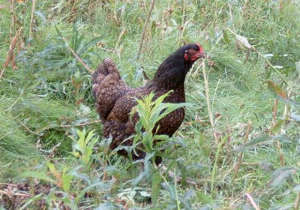
Chickens are omnivores and will both graze on a wide variety of greenery and insects. They will even eat mice and frogs! From our experience chickens are happiest when allowed to wander, find their own food and will spend about 40% of their time scratching around.
